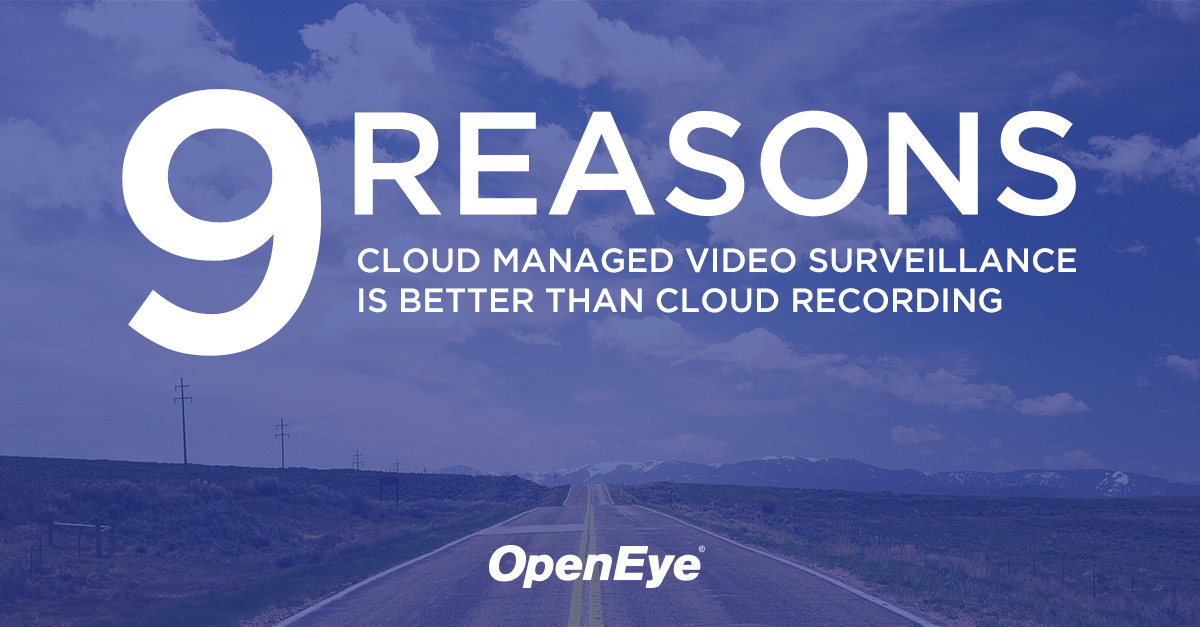When people hear "cloud" combined with video surveillance they often think of cloud recording and they know that 's not what they 're looking for. However, a more powerful and flexible option is available that combines the advantages of the cloud without forgoing the benefits of a local recorder. Cloud-managed video surveillance offers the convenience and intelligence of the cloud and the reliability of a physical recorder. Below are nine key benefits of a cloud-managed system that should make you think twice the next time you hear cloud.
- Recording Reliability
Local on-site system recording ensures video is recorded even if internet connectivity is lost. If internet connection reliability is a concern, the ability to record while the internet is down can be a major deciding factor in choosing a cloud-managed surveillance solution. - Data Security
Many end-users want to ensure that their video does not leave the premises without user intervention. A cloud-managed solution allows users to record locally and only transmit video for remote viewing or export. - LAN Performance
When users access video primarily on the local area network, an on-premises recorder can drastically improve performance. Video can be streamed entirely over the LAN without utilizing bandwidth through the internet connection. The first benefit of this is reduced latency while viewing live video (latency is far more noticeable when a user is on location). The second benefit is less load on the internet bandwidth; which is especially important if the site has POS data, slower internet speeds, or large camera counts. - Total Cost of Ownership
On average, users only view and export an extremely small percentage of the video that their systems record. So why add the cost to move all recorded video into the cloud and store it there when most of it will never be used? HIgher speed internet packages and monthly cloud recording fees add up fast, especially as more cameras are installed and you look at the reurring cost over multiple years. When looking at the total cost of ownership for cloud recording it can quickly become too expensive making cloud video management more viable than cloud video recording. - Bandwidth Limitations
In many locations, the monthly cost of an internet connection with enough uplink bandwidth to record 16+ streams of megapixel video to the cloud can be cost prohibitive. Outside of major metropolitan areas, internet service providers may not even offer an option that provides enough uplink bandwidth. This often translates into sacrificed video quality, through reduced video resolutions and frame rates, to get video data into the bandwidth available. - Future Upgrades and Compatibility
Having an on-site recording device allows more flexibility in integrating with 3rd party hardware and technology providers. The custom nature of many cloud recording systems makes it hard to upgrade and change devices over time. Having a dedicated on-site box allows more potential for upgrading technology over time. This includes cameras, edge analytics, alarm panels, people counters, and physical sensors. - Local Access
Many companies who purchase security solutions do not have another PC system on site for use by employees or managers. The local console of an on-site recorder allows users to log in to search video for incidents which have occurred and export clips without the need for an additional PC. The console also restricts users to only security functions vs an open PC that can be used to browse the internet and must be managed and patched for security. - Remote Troubleshooting
An on-site recorder provides a bridge to the local user 's network to manage and monitor cameras. If a camera stops working the installer can access the camera to troubleshoot remotely and, depending on the recorder model, even power cycle the camera in an attempt to bring it back online so a technician does not have to go on-site to fix it. This can result in significant savings on system maintenance over time and improved uptime. - Retrofit Option for Existing Systems
A hybrid recording option that supports IP and includes a built-in encoder, for standard analog and TVI cameras can provide a path to retrofit existing analog installations, with the option to add IP video and cloud connectivity, that might otherwise be cost prohibitive if users were required to replace all their cameras and rewire the installation.
****************************
OpenEye Web Services is a cloud managed video surveillance platform. OpenEye believes that a cloud-managed solution takes the best parts of local recording and cloud recording and eliminates some of the pitfalls. A video surveillance solution using OpenEye Web Services provides the performance and reliability of a dedicated on-site recorder with the convenience and labor savings of managing recorders and users from a secure centralized location.
